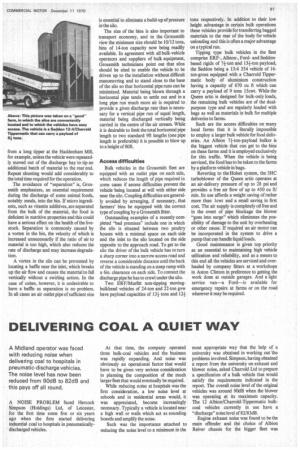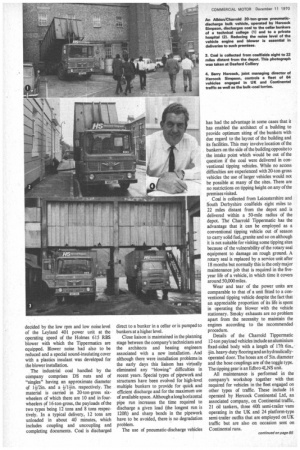DELIVERING COAL A QUIET WAY
Page 87

Page 88

If you've noticed an error in this article please click here to report it so we can fix it.
A Midland operator was faced with reducing noise when delivering coal to hospitals in pneumatic-discharge vehicles. The noise level has now been reduced from 90dB to 82dB and this pays off all round.
A NOISE PROBLEM faced Hercock Simpson (Holdings) Ltd, of Leicester, for the first time some five or six years ago when the firm started delivering industrial coal to hospitals in pneumaticallydischarged vehicles. At that time, the company operated three bulk-coal vehicles and the business was rapidly expanding. And noise was obviously an operational factor that would have to be given very serious consideration in planning the composition of the much larger fleet that would eventually be required.
While reducing noise at hospitals was the first consideration, a low noise level at schools and in residential areas would, it was appreciated, become increasingly necessary. Typically a vehicle is located near a high wall or walls which act as sounding boards and amplify the noise.
Such was the importance attached to reducing the noise level to a minimum in the most appropriate way that the help of a university was obtained in working out the problems involved. Simpson, having obtained a report from the university on exhaust and blower noise, asked Charrold Ltd to prepare a specification of a bulk vehicle that would satisfy the requirements indicated in the report. The overall noise level of the original vehicles was around 90dB when the blower was operating at its maximum capacity. The 12 Albion/Charrold-Tippermatic bulkcoal vehicles currently in use have a "discharge" noise level of 82/83dB.
Engine exhaust noise was found to be the main offender and the choice of Albion Reiver chassis for the bigger fleet was decided by the low rpm and low noise level of the Leyland 401 power unit at the operating speed of the Holmes 615 RBS blower with which the Tippermatics are equipped. Blower noise had also to be reduced and a special sound-insulating cover with a plastics insulant was developed for the blower installation.
The industrial coal handled by the company comprises DS nuts and of "singles" having an approximate diameter of 11/2in. and a -1/1 +in. respectively. The material is carried in 20-ton-gross sixwheelers of which there are 10 and in fourwheelers of 16-ton-gross, the payloads of the two types being 12 tons and 8 tons respectively. In a typical delivery, 12 tons are unloaded in about 40 minutes, which includes coupling and uncoupling and completing documents. Coal is discharged direct to a bunker in a cellar or is pumped to bunkers at a higher level.
Close liaison is maintained in the planning stage between the company's technicians and the architects and heating engineers associated with a new installation. And although there were installation problems in the early days this liaison has virtually eliminated any "blowing" difficulties in recent years. Special types of pipework and structures have been evolved for high-level multiple bunkers to provide for quick and efficient discharge and for the maximum use of available space. Although a long horizontal pipe run increases the time required to discharge a given load (the longest run is 120ft) and sharp bends in the pipework have to be avoided, there is no degradation problem.
The use of pneumatic-discharge vehicles has had the advantage in some cases that it has enabled the architect of a building to provide optimum siting of the bunkers with due regard to the layout of the building and its facilities. This may involve location of the bunkers on the side of the building opposite to the intake point which would be out of the question if the coal were delivered in conventional tipping vehicles. While no access difficulties are experienced with 20-ton-gross vehicles the use of larger vehicles would not be possible at many of the sites. There are no restrictions on tipping height on any of the premisesvisited.
Coal is collected from Leicestershire and South Derbyshire coalfields eight miles to 22 miles distant from the depot and is delivered within a 50-mile radius of the depot. The Charrold Tippermatic has the advantage that it can be employed as a conventional tipping vehicle out of season to carry solid fuel, granite and so on although it is not suitable for visiting some tipping sites because of the vulnerability of the rotary seal equipment to damage on rough ground. A rotary seal is replaced by a service unit after 18 months but normally this is the only major maintenance job that is required in the fiveyear life of a vehicle, in which time it covers around 50,000 miles.
Wear and tear of the power units are comparable to that of a unit fitted to a conventional tipping vehicle despite the fact that an appreciable proportion of its life is spent in operating the blower with the vehicle stationary. Smoky exhausts are no problem apart from the necessity to maintain the engines according to the recommended procedure.
Details of the Charrold Tippermatic 12-ton payload vehicles include an aluminium fixed-sided body with a length of 17ft 6in., +in. heavy-duty flooring and an hydraulicallyoperated door. The hoses are of 5in. diameter and the hose couplings are of the toggle type. The tipping gear is an Edbro 4LNS unit.
All maintenance is performed in the company's workshop together with that required for vehicles in the fleet engaged on other types of traffic. These include 16 operated by Hercock Continental Ltd, an associated company, on Continental traffic, 21 oil tankers, three 40ft semi-trailer vans operating in the UK and 24 platform-type semi-trailer outfits that are employed on UK traffic but are also on occasion sent on Continental runs.






























































































































































